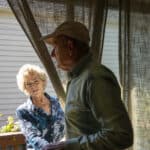Elaine Oster says her hearing isn’t what it used to be and she’s frustrated that her balance isn’t better.
She’s also being treated for macular degeneration.
But she exercises regularly at the 92nd Street YMCA near her home on the Upper East Side of Manhattan; gets around the city most often by public transportation; shops with her grandchildren; keeps up her bead weaving, watercolor painting and bridge playing; and is, in the words of one of her daughters, “tech savvy.’’ And, as Oster put it, “I handle all my financial business.’’
Oster is 97; her mother lived to 98. Three of her immediate family members have lived beyond 95. She had five children from two marriages; both husbands pre-deceased her. She is a colon cancer survivor.
Oster is one of the so-called SuperAgers that the Albert Einstein College of Medicine’s Institute for Aging Research’s Longevity Genes Project and Boston University are studying to see why some people live to very ripe ages and, until their final years, without age-related disease or disability.
The next study, called SuperAgers Initiative, is to begin in August, with 250 participants. Results from this first phase will be available in one year. The goal is to add up to 10,000 participants to the study within the next two to three years.
SuperAger Statistics
Japan has the most SuperAgers, by percentage of total population, at an estimated one in about 1,500 persons being at least 100. Eighty-eight percent of these centenarians are women. The United States has the largest number of SuperAgers overall, but globally it has the smallest percentage — 1% — of its total population. Most of these elderly individuals live in highly populated states such as California, New York, Florida, Pennsylvania and Texas. This data is from the 2010 U.S. Census.
Globally there are 600,000 SuperAgers, those who are 100 or older, according to the institute.
The Institute for Aging Research was founded in 1981 and has awarded more than $200 million in research grants to more than 4,300 investigators conducting biomedical research on aging and aging-related disease, said Judith Graham, moderator of the recent virtual event.
Oster said she does the usual good things to stay well: exercise, healthy diet, engagement with friends and family, and maintaining an optimistic attitude. A retired school social worker, she has been widowed twice and lives alone.
But the director of Human Longevity Studies at the institute said that eating a healthy diet and exercising are not an assured indicator of why SuperAgers live so long.
SuperAgers Have Vices, Too
“SuperAgers are no less likely to smoke, drink alcohol, or more likely to have a low calorie, low fat, low salt diet than the control group (in the study). So, there are no lifestyle differences and yet they achieve superage,’’ said Sofiya Milman, M.D., associate professor of endocrinology and geriatrics at the Albert Einstein College of Medicine, and director of Human Longevity Studies at the Institute for Aging Research.
And the offspring of SuperAgers, such as Oster’s daughter, Debbi Marcus, who participated in the webinar, “seem to be protected from heart disease, diabetes and stroke,’’ Milman said.
“This is not to say that the rest of us should not exercise, eat a healthy diet and avoid smoking. But for those who have exceptional longevity in their families, lifestyle is less important than other factors,’’ Milman said.
In Search of the X Factor
That X factor is what the institute wants to understand. Millman asked attendees of the webinar who are SuperAgers or who know them to consider participating in the institute’s upcoming clinical study. Ideally, the institute is looking for 10,000 participants who are 95 and older; their offspring are asked to participate, too. An application is available online to determine eligibility to participate.
The long-term goal of the project is to “help develop and fast-track new therapies that target the biological processes of aging and potentially address multiple age-related diseases and conditions at the same time,’’ the College’s website states.
Milman showed a slide of four siblings in a study: two girls and two boys, who lived until 101, 103, and two until 109.
“So we believe that there is a high potential for inheriting the (longevity) factor,’’ she said.
Milman said that for many older Americans, the last 10 to 20 years of life are plagued with disability and disease.
“By the time SuperAgers have reached 100, 50% are still healthy and have no age-related disease or disability.’’ — Sofiya Milman, MD
“But, by the time SuperAgers have reached 100, 50% are still healthy and have no age-related disease or disability,’’ she said.
In the United States, Milman said, 80% of the people who reach 100 are Caucasian; about 5% are African American, and the rest are from a diverse group of ethnicities.
Goals for 100
Aside from the lofty goals of the SuperAgers Initiative, there are Oster’s more personal goals.
“My oldest great-grandson will be bar mitzvahed when I am 100, and I want to get to that standing up. My goal is to keep my body strong enough to do all these things,’’ Oster said, then stops to answer a ringing telephone.
“I am very well-connected with lots of good friends,’’ she smiled after hanging up the telephone.
Her daughter also added some comments. “My mother feels very confident that she will reach out for help when she needs it. She is a SuperAger but she’s not trying to be a super-hero,” Marcus said. “There are the few times that she will ask for help: She gets shots for macular degeneration and she relies on wonderful, dear friends to take her to those shots.’’
Oster said a big challenge of being old is to continue to “move through the world and not to have to have things done for you.’’
A webinar attendee asked Oster if personality plays a role in longevity.
“Yes; I think that I was always optimistic and it is certainly true of me now. It’s hard to be optimistic with the world as it is, but I still believe that optimism and thinking that things will get better are very, very important.
“And I think it’s important not to surround yourself with people who are downers. Most of my friends are just the way I am: We go to shows, museums, and enjoy all the beauty in the world; we don’t focus on the bad stuff, we focus on what’s really important,’’ Oster said.
The webinar, to launch the SuperAgers Initiative, was presented on June 30 by The American Federation for Aging Research and the Albert Einstein College of Medicine.
In a four-decade career in journalism, Eleanor O’Sullivan has reviewed many books on best practices for financial advisors, has written for Financial Advisor and the USA Today network, and was movie critic for the Asbury Park Press.







